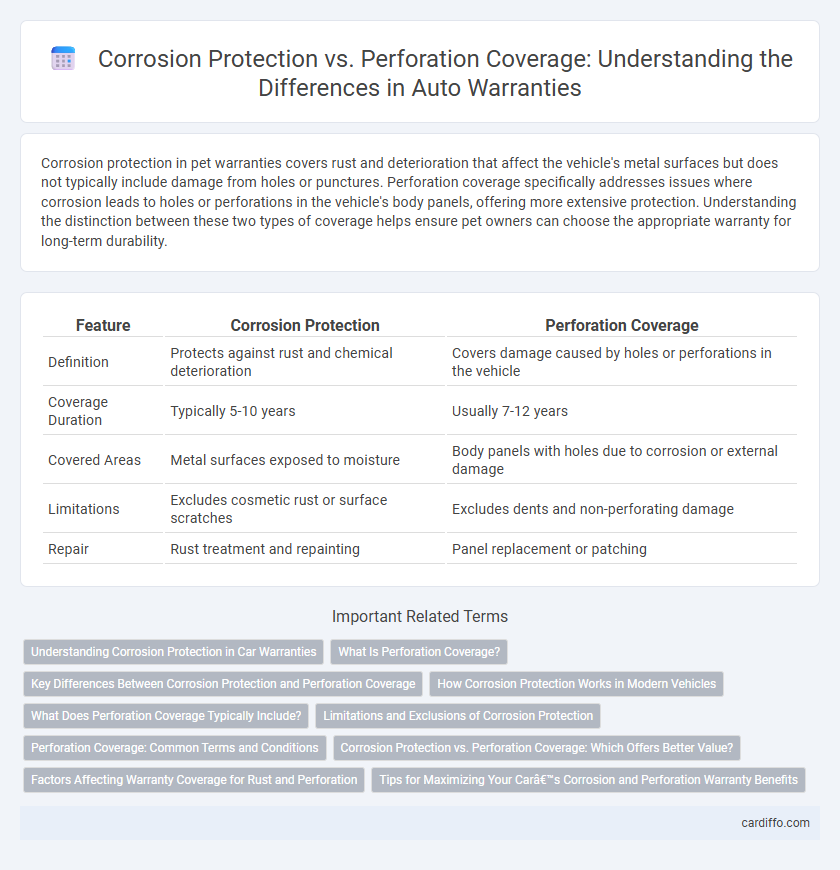Corrosion protection in pet warranties covers rust and deterioration that affect the vehicle's metal surfaces but does not typically include damage from holes or punctures. Perforation coverage specifically addresses issues where corrosion leads to holes or perforations in the vehicle's body panels, offering more extensive protection. Understanding the distinction between these two types of coverage helps ensure pet owners can choose the appropriate warranty for long-term durability.
Table of Comparison
| Feature | Corrosion Protection | Perforation Coverage |
|---|---|---|
| Definition | Protects against rust and chemical deterioration | Covers damage caused by holes or perforations in the vehicle |
| Coverage Duration | Typically 5-10 years | Usually 7-12 years |
| Covered Areas | Metal surfaces exposed to moisture | Body panels with holes due to corrosion or external damage |
| Limitations | Excludes cosmetic rust or surface scratches | Excludes dents and non-perforating damage |
| Repair | Rust treatment and repainting | Panel replacement or patching |
Understanding Corrosion Protection in Car Warranties
Corrosion protection in car warranties typically covers rust that affects the vehicle's metal surfaces by preventing or repairing damage caused by exposure to moisture and chemicals. Unlike perforation coverage, which specifically addresses rust holes that penetrate through the metal, corrosion protection includes surface rust and preventative treatments. This distinction ensures that consumers know whether their warranty covers minor rust issues or only advanced damage leading to perforation.
What Is Perforation Coverage?
Perforation coverage in warranties specifically protects against damages caused by rust or corrosion that results in holes through metal surfaces, typically on a vehicle's body panels. This coverage is crucial because it addresses structural integrity losses that standard corrosion protection may not fully cover. It ensures repairs or replacements when rust penetrates completely, preventing leaks, weak spots, and further deterioration.
Key Differences Between Corrosion Protection and Perforation Coverage
Corrosion protection in warranties typically covers damages caused by rust or corrosion on the vehicle's metal surfaces, preventing gradual deterioration. Perforation coverage specifically addresses holes or penetrations caused by corrosion that lead to visible openings or structural compromise. The key difference lies in corrosion protection aiming to halt the rusting process, while perforation coverage guarantees repair or replacement when corrosion results in actual holes.
How Corrosion Protection Works in Modern Vehicles
Corrosion protection in modern vehicles utilizes advanced coatings and sealants to prevent rust formation by creating a durable barrier against moisture and salt exposure. Electrophoretic deposition (e-coating) is a key technology that ensures even coverage on complex metal surfaces, enhancing long-term resistance to corrosion. This preventive approach differs from perforation coverage, which only addresses rust once it causes structural damage, emphasizing the importance of proactive corrosion protection in vehicle longevity.
What Does Perforation Coverage Typically Include?
Perforation coverage in warranties typically includes protection against rust and corrosion that causes holes or breaches in the vehicle's body panels, such as doors, roofs, and floor pans. This coverage often extends to factory-applied coatings but excludes damage from environmental factors like stone chips or scratches, ensuring repairs or replacements are covered when corrosion penetrates the metal fully. Understanding the specific terms of perforation coverage is essential, as policy limits and duration can vary by manufacturer and warranty type.
Limitations and Exclusions of Corrosion Protection
Corrosion protection warranties typically exclude damages caused by environmental factors such as chemical exposure, inadequate maintenance, or improper installation, limiting coverage strictly to corrosion resulting from manufacturing defects. Perforation coverage often extends beyond surface corrosion to include holes caused by rust, while corrosion protection may not cover deeper structural damage or gradual wear and tear. Understanding these limitations is crucial for homeowners to avoid unexpected repair costs associated with excluded corrosion scenarios.
Perforation Coverage: Common Terms and Conditions
Perforation coverage in warranty terms protects against metal loss from rust holes caused by corrosion, typically requiring proof of perforation through an inspection process. Common conditions include limitations on coverage duration, specified warranty regions, and exclusions for surface rust or external damage unrelated to corrosion. Policyholders must often maintain regular vehicle maintenance and report defects promptly to qualify for perforation claims.
Corrosion Protection vs. Perforation Coverage: Which Offers Better Value?
Corrosion protection warranties typically cover the gradual deterioration of metal surfaces due to environmental factors, extending the lifespan of vehicle components. Perforation coverage, on the other hand, specifically addresses rust holes that penetrate the metal, often providing more comprehensive protection against severe damage. Evaluating which offers better value depends on factors such as climate, usage, and vehicle material quality, but perforation coverage generally delivers higher long-term savings by preventing structural damage.
Factors Affecting Warranty Coverage for Rust and Perforation
Warranty coverage for rust and perforation depends on factors such as the type of metal, environmental exposure, and maintenance practices. Manufacturers often specify corrosion protection limits based on thickness loss and visible rust, while perforation coverage requires evidence of holes penetrating the metal sheet. Variations in climate, road salt exposure, and paint quality significantly influence the duration and extent of corrosion and perforation warranty claims.
Tips for Maximizing Your Car’s Corrosion and Perforation Warranty Benefits
To maximize your car's corrosion and perforation warranty benefits, regularly wash and inspect the vehicle to remove salt and debris that accelerate rust formation. Keep detailed records of all maintenance and repairs related to corrosion control, as manufacturers often require proof for warranty claims. Use recommended protective coatings and address any paint damage promptly to prevent rust from compromising the warranty coverage.
Corrosion Protection vs Perforation Coverage Infographic

 cardiffo.com
cardiffo.com